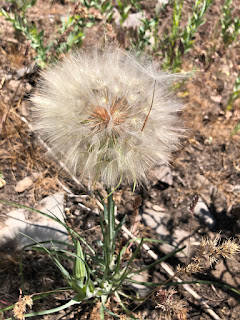 |
| Tragopogon porrifolius |
This is an unusual plant in my region, but on a recent hike I found a stand of Tragopogon porrifolius, commonly known as Oyster Root or Salsify. I prefer to call it Purple Salsify to distinguish it from the Yellow Salsify, Tragopogon dubium, which is more common in this area.
All parts of the plant are more-or-less edible. The best parts are the flower and the root. The flowers taste the same as Tragopogon dubium (Yellow Salsify), and I have written about them in my article on that plant. I'm not going to repeat that here, so go there to read more about eating the flowers.
The root is what most people are interested in when they talk about Tragopogon porrifolius. It has even been cultivated for for the root, famously by Thomas Jefferson after Lewis and Clark brought samples back from their explorations. And it deserves the recognition it gets.
One thing I noticed about the Purple Salsify plants I found is that even thought the flowers are the same size, they grow about twice as tall as Yellow Salsify. The first-year plants were also about twice as tall, stouter, and with many more leaves than Yellow Salsify. This size difference applies to the root as well, so, geometrically speaking, the roots should be eight times the volume. The roots I found were harvested in July (mid-summer) instead of in the fall when they would be the largest, but they were already much larger and plumper than the scrawny, woody roots of T. dubium. In a well-cared-for garden, they can get much larger still.
When harvesting the roots, remember that this is a biennial, so if the plant has flowers, the roots will have gone woody, and will not be good to eat. In the wild, the flowers are much more noticeable, but you can look around and spot the first-year plants. They grow from a dense cluster of grass-like leaves, but unlike grass, when broken they have milky sap. It is fortunate that they are much larger than Yellow Salsify, because that makes it easier to distinguish the first-year plant from the actual grasses growing around them.
I boiled my roots for 10 minutes. I did not try to peal them first, but the outer skin rubs off fairly easily after cooking. I tried with and without the skin and didn't notice much difference in taste. It has a good flavor. I don't think it tastes much like oysters, but I'm not a big fan of oysters, so my opinion probably doesn't count. The best description we could come up with is somewhere between a potato and a carrot. After cooking, is it fairly soft, but it seems to have some fibers too, so slicing it before serving will cut those fibers so only the soft texture is evident. Overall, these root are a very good meal, with a size and flavor which makes it well worth seeking them out.
Since the leaves of the first-year plants are abundant, I tried cooking them, by boiling or frying. While the taste is fine, they are rather tough and fibrous, so it is much like eating grass. Some sources have suggested using them in a salad, but I don't enjoy trying to chew them up raw, and cooking them did not help either.

